How “Buy All, Sell All” Works in Solar (And Why It’s a Great Deal for You)
At Infinity Solar USA, we’re all about maximizing your solar savings, and today, we’re diving into one of the coolest ways you can get paid for your excess energy: Buy All, Sell All. It might sound like a shopping spree, but trust us, it’s even better. Here’s how it works—and why you’ll love it.
1. What is “Buy All, Sell All”?
In the Buy All, Sell All setup, your solar panels generate all the electricity your home needs—and any extra power gets sold back to the grid. Essentially, your utility company purchases all of the energy your system produces, even if you don’t use it all.
The cool part? You buy your electricity from the grid just like anyone else, but if your solar panels produce more than your home needs, you sell that excess energy back at a set rate.
2. How Does It Work?
Here’s the breakdown:
- Your solar system generates electricity for your home.
- When your home needs less electricity than your system produces (hello, sunny days!), the extra energy gets sent to the grid.
- You sell that excess energy back to the utility company at an agreed-upon rate.
So, whether you’re using your solar power or sending it to the grid, the energy you generate is being bought (by the grid) or used (by your home). This setup is perfect for homeowners who want to take full advantage of their solar system’s output.
3. The Perks of “Buy All, Sell All”
- Earn Money for Excess Energy: Instead of just letting the extra power go to waste, you’re actually getting paid for it. Sell your excess energy back and watch those credits pile up.
- Maximize Solar Production: Your system works hard to generate energy, and with Buy All, Sell All, you’re turning every last drop of sunshine into savings.
- Fixed Electricity Rates: In many cases, you’ll have a set rate for the energy you buy from the grid, which helps keep your electricity costs predictable.
4. What’s the Catch?
Here’s the catch: Buy All, Sell All isn’t for everyone. Some states or utility companies may offer more attractive net metering policies (like 1:1 net metering), where you earn credits for your excess energy at the same rate as you pay for grid electricity. With Buy All, Sell All, the rates for selling energy may not always be the same as the rate you pay for electricity from the grid. But don’t worry—even at a slightly lower rate, you’re still getting a sweet deal.
5. Why You’ll Love It
The bottom line is this: Buy All, Sell All lets you turn every single watt of your solar energy into something valuable. Whether you’re powering your home with sunshine or selling it back to the grid, you’re making the most of what you produce—and that’s what solar is all about.
Bottom Line?
If you’re all about maximizing your solar output and getting paid for your surplus energy, Buy All, Sell All might be your new favorite solar option. Ready to see how much you could earn by selling your excess solar power? Contact Infinity Solar USA and let’s chat about the best options for you.
Buy All, Sell All—It’s not just a catchy phrase; it’s a win for your wallet. 🌞💰
More Blog Posts
More Guides For You From Our Help Center
Service and Troubleshooting
Understanding your solar system performance
How to schedule a repair
Solar Financing and Incentives
How does net metering work?
- How Net Billing Works (And Why Export Credits Are Your New Best Friend)
- How "Buy All, Sell All" Works in Solar (And Why It’s a Great Deal for You)
- How Monthly Net Metering Works (Spoiler: It’s Like a Bank for Your Energy)
- What is Net Metering and Why It Matters in the Solar Industry?
- What Is 1:1 Net Metering, and Why Should You Care? (Hint: It’s Awesome)
Solar financing. Understanding your options
- Explore Your Financing and Cash Options for Going Solar with Infinity Solar USA
- Commercial Solar Solutions: What You Need to Know from Infinity Solar USA
- Solar Installation Costs and Financial Incentives: What You Need to Know from Infinity Solar USA
- Why Solar Loans Reamortize in Month 19: A Closer Look
System Performance
How to optimize your solar systems performance
How peak sun hrs works in solar
How does roof pitch and orientation affect solar production?
How shading and irradiation affect solar production
Solar 101
Understanding your solar energy savings
Different purchase options:
How do I save money with solar?
Solar Process
Step 1 Proposal Introduction
Step 2 Construction Pipeline Process
Step 3 Permission to Operate
Service and Troubleshooting
Understanding your solar system performance
How to schedule a repair
Solar Financing and Incentives
How does net metering work?
- How Net Billing Works (And Why Export Credits Are Your New Best Friend)
- How "Buy All, Sell All" Works in Solar (And Why It’s a Great Deal for You)
- How Monthly Net Metering Works (Spoiler: It’s Like a Bank for Your Energy)
- What is Net Metering and Why It Matters in the Solar Industry?
- What Is 1:1 Net Metering, and Why Should You Care? (Hint: It’s Awesome)
Solar financing. Understanding your options
- Explore Your Financing and Cash Options for Going Solar with Infinity Solar USA
- Commercial Solar Solutions: What You Need to Know from Infinity Solar USA
- Solar Installation Costs and Financial Incentives: What You Need to Know from Infinity Solar USA
- Why Solar Loans Reamortize in Month 19: A Closer Look
System Performance
How to optimize your solar systems performance
How peak sun hrs works in solar
How does roof pitch and orientation affect solar production?
How shading and irradiation affect solar production
Solar 101
Understanding your solar energy savings
Different purchase options:
How do I save money with solar?
Solar Process
Step 1 Proposal Introduction
Step 2 Construction Pipeline Process
Step 3 Permission to Operate



